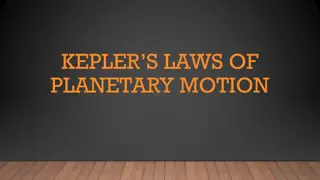Understanding Newton's Law of Gravitation and Kepler's Laws of Planetary Motion
Explore the gravitational constant, force of attraction between objects, and equations for calculating gravitational force and centripetal force. Delve into Kepler's laws describing planetary orbits. Uncover the relationship between periods and distances of planets from the sun.
Download Presentation

Please find below an Image/Link to download the presentation.
The content on the website is provided AS IS for your information and personal use only. It may not be sold, licensed, or shared on other websites without obtaining consent from the author. Download presentation by click this link. If you encounter any issues during the download, it is possible that the publisher has removed the file from their server.
E N D
Presentation Transcript
Monday, February 17th Copy equations from notes onto your own paper. Also, copy any other information you think you might need as you go through this power point with sub. After the power point, you will be given an assignment.
Newtons Law of Gravitation G= 6.67 E -11 Nm2/kg2 AKA Gravitational Constant
This equation can be used to find the force of attraction between any two objects. R should be the distance between the objects from center to center. Both objects will have the same magnitude of force on each (Newton s 3rd law)
Fg=mg=GMm/R2 We can equate mg with Newton s Law of Gravitation equation when an object is near the surface. M= mass of planet, R= radius of planet, m=mass of object (which cancels) If object is not near surface, radius of planet would need to be added to height above planet.
F=GMm/R2= mv2/R We can equate Newton s Law of Universal Gravitation with the centripetal force equation when working with objects in orbit (like satellites or planets) M= mass of larger object such as earth (compared to satellite traveling around earth), m= mass of satellite, R is distance from center to center. Notice mass of object that is orbiting is cancelled out. Mass of object that is being orbited is important.
Keplers First Law: The path of the planets about the sun is elliptical in shape, with the center of the sun being located at one focus.
Keplers Second Law: An imaginary line drawn from the center of the sun to the center of the planet will sweep out equal areas in equal intervals of time. In other words, the planet moves faster as it gets closer to the sun and slower as it gets farther from the sun. More KE closer to sun and more PE further from sun.
The ratio of the squares of the periods of any two planets is equal to the ratio of the cubes of their average distances from the sun I don t think you will be using this equation for AP, but if you do, the first thing you should do is take off the parenthesis above and square everything separately- like the picture to the right.
Assignment: Each student needs to get a buff colored (NOT YELLOW) GRAVITATION packet from the front of the classroom in the bins near the door. Get both the question and the answer packet (both buff in color). Spend the rest of class working on both MC and FR parts of the packets. Quiz next class over torque and gravitation.























